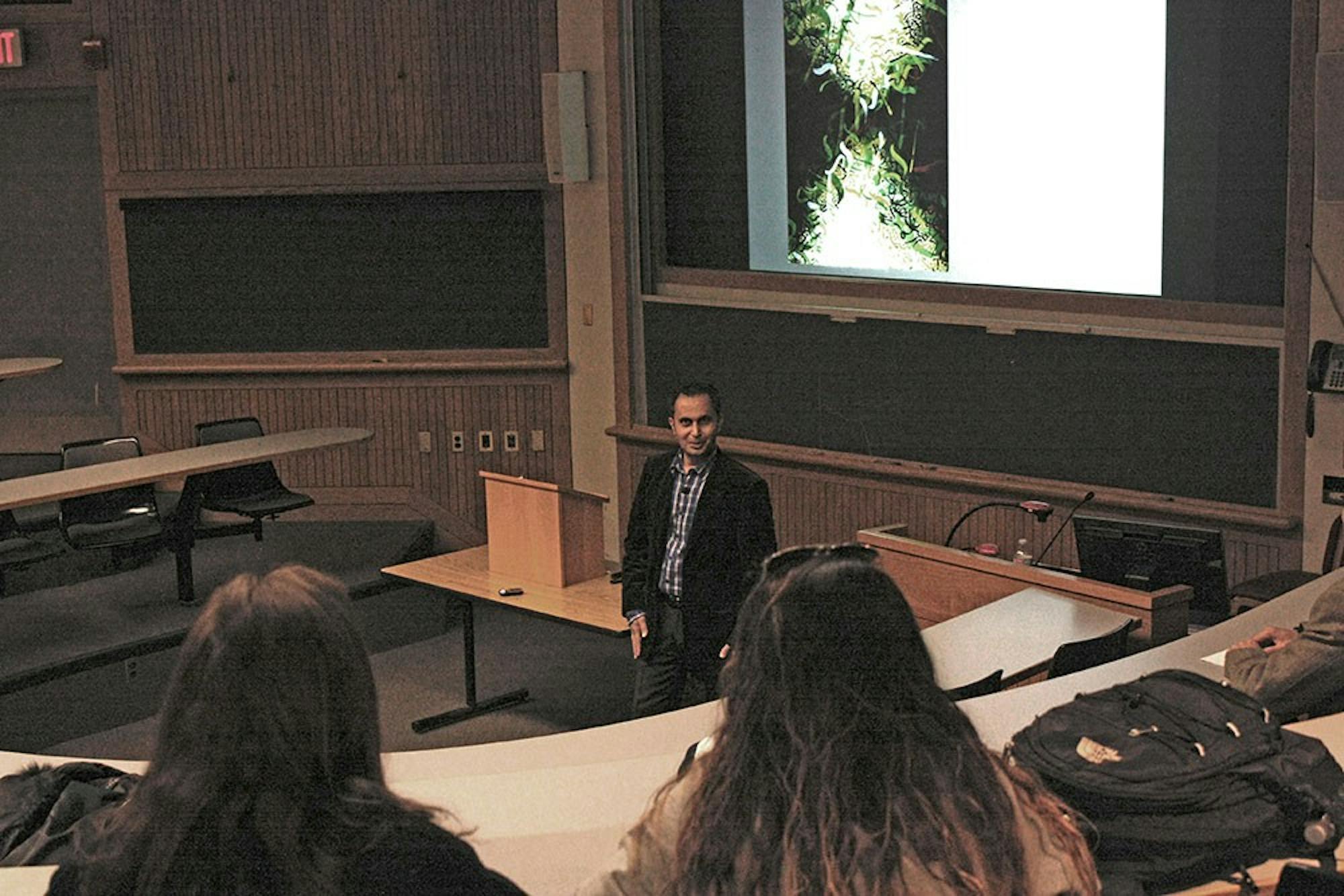Al-Saai, a Syrian born artist, has exhibited his work all over the world, but last night he brought his works to Hanover. Khaled Al-Saai gave a presentation on the subject of his artwork, called “Away from Home: A Presentation by the Artist,” which features Arabic calligraphy. His most recent exhibition, a mural on the subject of the Syrian civil war, was displayed in Germany.
Despite his most recent work’s political nature, most of Al-Saai’s artwork is abstract. He focuses on the calligraphy not as words with meaning, but as shapes used for their aesthetic appeal, Al-Saai said.
Al-Saai began his presentation by showing various examples of his artwork. Although the works differ, Arabic calligraphy connects them all, as well as a distinct style. In each work, he contrasts colors, usually light and dark, an effect accentuated by the presence of the calligraphy which usually occupies one area of the artwork.
Despite these overarching similarities, the works aesthetically differ because of the varied techniques that Al-Saai uses to create each one. He has used flourescent paint, paint mixed with sand and other mediums to create different types of feeling.
“The inspiration [for the medium] comes because of the idea for the work,” Al-Saai said.
Despite these varied painting techniques, Al-Saai likes to maintain an element of traditionality by using conventional tools and creating the colors for the paint himself by using natural materials.
The combination of tradition with modernity and calligraphy with abstraction sets Al-Saaim apart as an artist.
Although Al-Saai usually focuses on calligraphy as abstract shapes without a direct, intended message, his most recent artwork called “Away from Home” had a strong political message. Exhibited in Germany, the wall mural demonstrates Al-Saai’s thoughts on the Syrian conflict. Al-Saai incorporated media including photographs and newspaper articles that formed a type of collage.
Over the past five years, since the very beginning of the Syrian conflict, Al-Saai has been collecting newspaper clippings. These years of work cumulated in 13 days of creating the mural with his team of assistants in Germany.
This mural varies slightly from Al-Saai’s usual style because the calligraphy is not abstract. It features the names of Syrian towns affected by the civil war. Despite this aspect of literality, the work does maintain some abstractness.
“If I want to express it more, I need to twist it and play with the proportions and the size, put it upside-down, whatever,” Al-Saai said.
In addition to the names of Syrian towns, the mural also features words from other languages including English, French and German. There are also photographs of many of the towns and newspaper articles on the subject of the conflict. In addition, Al-Saai included painted images such as an oil barrel, an arrow and a card.
He said that the oil barrel represents to him what is at the heart of the conflict: oil. The arrow represents people exiting the conflict either through death or immigration. When people die, they go upwards to heaven, and when they leave Syria, they travel north. The card, which is a four of clubs, represents the four key figures in the conflict. The United States and the national community, specifically Europe, were the clubs on top of the card Al-Saai said, because they witnessed the conflict from above. The clubs on the bottom of the card were the Syrian rebels and the regime because they were actually in the midst of the conflict.
In reference to his decision to make a political statement, Al-Saai said, “Artists don’t always need to please. They can can convey pain and struggle.”
Al-Saai presents these feelings in his mural in Germany by using various media in addition to convey his own strong feelings about the Syrian civil war.
“I am trying to do something to serve my country,” Al-Saai said.
Despite this, he accepts that he will be unable to return to Syria during this time of conflict because of the controversy that his artwork has caused.
“This is my decision that I have already made,” Al-Saai said.
Graziella Parati, acting chair of the comparative literature department and director of the Leslie Humanities Center, said she was interested in bring Al-Saai to Dartmouth for many reasons, including his political stances. Firstly, she was interested in his political stance on the Syrian civil war, Parati said.
Parati said that finding speakers with knowledge about the Syrian civil war and refugees is a purposeful goal, considering the current refugee crisis.
In addition, Parati enjoys Al-Saai’s art work, and describing it as “very original.”
“He brings together a very traditional kind of art which is calligraphy with the ideas inspired by literature and contemporary issues,” Parati said. “It’s particularly valuable because he brings not so much an Islamic tradition but an Arabic tradition to modern times.”
Al-Saai’s political views is part of what makes his artwork so intriguing to onlookers.
Matthew Giegerich ’19, who attended the talk, said he thought Al-Saai’s artwork was very interesting.
“It was cool to see how a lot of the present day issues in Syria were reflected in his work,” Giegerich said.




